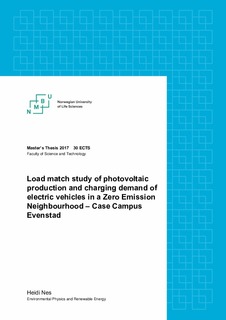| dc.contributor.advisor | Grimenes, Arne Auen | |
| dc.contributor.author | Nes, Heidi | |
| dc.date.accessioned | 2018-05-30T08:31:05Z | |
| dc.date.available | 2018-05-30T08:31:05Z | |
| dc.date.issued | 2017 | |
| dc.identifier.uri | http://hdl.handle.net/11250/2499730 | |
| dc.description.abstract | Campus Evenstad is a university campus and a pilot area in The Research Centre on Zero Emission Neighbourhoods in Smart Cities (FME ZEN). FME ZEN aims to optimize the energy management of energy production, energy demand and energy storage at campus. This thesis presents a load match analysis of photovoltaic (PV) energy production and the demand of electric vehicles charging at Campus Evenstad. Studying load match is necessary to decide possibilities on future interaction between PV production and charging demand at campus.
There are two charging stations at campus and this study denotes one station as slow charging station and one station as fast charging station. The demand at the slow charging station occurred in the morning according to charging data covering 01.04.2017 – 31.05.2017, while the demand at the fast charging station was distributed throughout the day with most charging events in the afternoon according to charging data covering 7.11.2016 – 3.09.2017. This suggests that the charging demand at campus is mainly by employees and visitors at campus.
The PV plant at Campus Evenstad is oriented towards the south and the rated power is 70 kWp. The PV production on five selected clear days in March through June was compared to three charging profiles which were selected according to different characteristics of the demand at the slow charging station. The hourly demand of the selected charging profiles covered up to 30 – 40 % of the hourly morning PV production, and less than 10 % of the hourly production around PV production peak hours. The daily PV production exceeds the energy demand of the selected charging profiles for about 98 % of the days in March through September according to PVsyst simulated production of a typical year. When studying load match between PV production and the demand at the fast charging station, it is evident that instantaneous PV coverage depends on peak hour production around 12:00 – 13:00 on clear days.
Based on scenario assumptions, the energy demand of 7, 14 and 21 vehicles charging at campus is set to 85 kWh, 170 kWh and 255 kWh and the energy demand is distributed throughout eight hours between 08:00 and 16:00. The production on every selected clear day was sufficient to supply the whole hourly demand except between 08:00 – 09:00 if 21 vehicles charge daily. The scenario demands covered up to 55 % of the production during production peak hour on selected clear days. The daily PV production exceeds the scenario demand of 21 vehicles charging daily for about 47 % of the days in March through September according to PVsyst simulated production of a typical year.
The load match between PV production and charging demand on cloudy days depends on the amount of cloud cover during demand hours. A charging system which adjusts the charging power to the PV production is in some cases necessary to ensure full hourly PV coverage of charging demand.
Load match analysis shows that the PV production coincides with found charging demand during work hours at Campus Evenstad. | nb_NO |
| dc.description.abstract | Campus Evenstad er ein høgskule-campus og eit pilotområde i Forskningssenter for nullutslippsområder i smarte byer (FME ZEN). FME ZEN har som mål å optimalisere energistyringa av energiproduksjon, energibehov og energilager. Denne masteroppgåva samanliknar fotovoltaisk (PV) energiproduksjon med ladeetterspurnad til elbilar som ladar på Campus Evenstad. Samanlikning av produksjon og ladebehov er nødvendig for å finne mogleg framtidig interaksjon mellom PV-produksjon og elbil-lading på campus. Det er to ladestasjonar på campus, og i denne oppgåva blir den eine stasjonen kalla sakteladestasjon og den andre stasjonen blir kalla hurtigladestasjon. Ladeetterspurnaden på sakteladestasjonen var hovudsakleg på morgonen ifølge ladedata frå tidsrommet 01.04.2017 - 31.05.2017, medan ladeetterspurnaden på hurtigladestasjonen var fordelt utover heile dagen med størst etterspurnad på ettermiddagen ifølge ladedata frå tidsrommet 07.11.2016 - 03.09.2017. Dette tydar på at ladebehovet på campus er hovudsakleg blant tilsette og besøkande på campus. | nb_NO |
| dc.language.iso | eng | nb_NO |
| dc.publisher | Norwegian University of Life Sciences, Ås | nb_NO |
| dc.rights | Attribution-NonCommercial-NoDerivatives 4.0 Internasjonal | * |
| dc.rights.uri | http://creativecommons.org/licenses/by-nc-nd/4.0/deed.no | * |
| dc.title | Load match study of photovoltaic production and charging demand of electric vehicles in a zero emission neighbourhood : case Campus Evenstad | nb_NO |
| dc.type | Master thesis | nb_NO |
| dc.subject.nsi | VDP::Teknologi: 500 | nb_NO |
| dc.description.localcode | M-MF | nb_NO |

